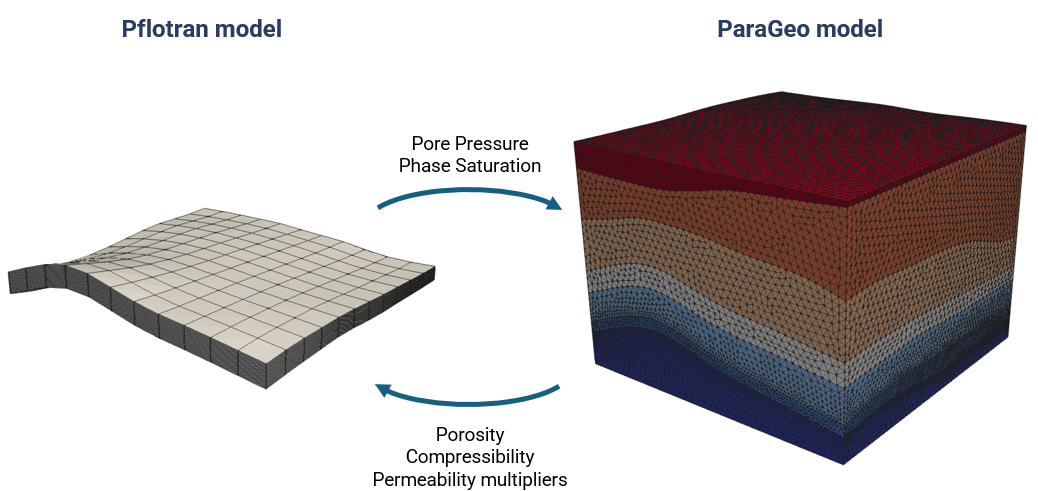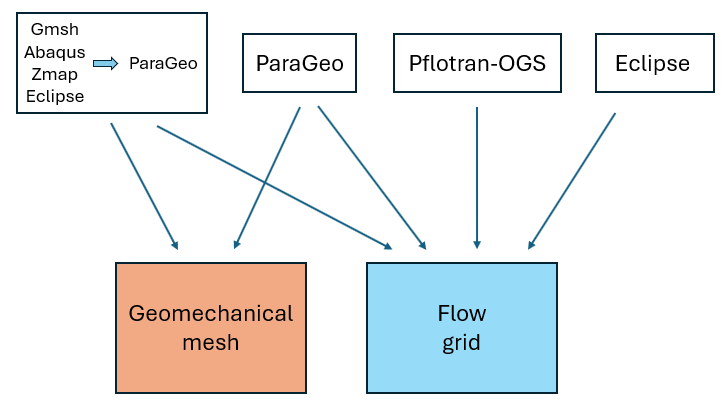ParaGeo-Pflotran Coupling Overview
Coupling Features Overview
To simulate multiphase flow in porous media ParaGeo may be coupled to either Pflotran or Pflotran-OGS. In such coupled settings any of the two variants of Pflotran are used to simulate multiphase flow (and optionally the thermal field) in the selected groups to be coupled while ParaGeo deals with solving the mechanical field (and optionally the Thermal field if not solved in Pflotran). Usually the flow model mesh (Pflotran / Pflotran-OGS) only encompasses the reservoir and / or any key high perm formations while the geomechanical model mesh (ParaGeo) encompasses the full stratigraphy including all formations in the overburden and underburden. The formations that will be represented in the flow model mesh will be called from now onwards the "coupled groups" whereby there will be exchange of data between ParaGeo and Pflotran at each coupling step to update the distribution of pressure, phase saturation, temperature, material properties, etc.
Some key features of the coupling workflow are:
•Flexibility in performing either 2 way or 1 way coupling.
•Automatic generation of Pflotran mesh data (.ugi) and PflotranOGS eclipse grid data (.grdecl) for the coupled formations from ParaGeo.
•Mapping of data and state variables for cases with non-matching meshes between the Pflotran and ParaGeo models.
•Mapping and conversion of properties from discrete faults in the geomechanical model to continuum in the flow model (not available yet).
•Output of results in ResInsight format.

Schematic of coupling between ParaGeo and Pflotran / Pflotran-OGS where only the reservoir is solved in Pflotran (coupled group)
ParaGeo-Pflotran model building workflows
ParaGeo has numerous capabilities in importing and exporting meshes from different formats. This includes the capability of exporting both; eclipse .eclgrd and .ugi files containing the mesh for those formations that will be solved by Pflotran-OGS or Pflotran. This opens several potential workflow pathways in the building of the moldel's geometry and mesh for ParaGeo-Pflotran coupled simulations. The potential combinations are shown in the figure below, where geomechanical mesh refers to the mesh of the ParaGeo simulation model (which will solve the mechanical field) and flow grid refers to the Pflotran / Pflotran-OGS simulation model (which will solve for the flow and if defined to do so, for the thermal field as well).
For example one might build a geometry in Gmsh and export it in .inp format to later convert it to ParaGeo .geo format. Then using that meshed geometry one might use ParaGeo to export the reservoir grid in eclipse format for usage in Pflotran-OGS. Note that any spacial distribution of properties may be imported / exported as well.
It is noted that for cases in which the flow grid is not exported from ParaGeo, the geomechanical mesh and the flow grid might not match for the coupled groups (i.e. element / cell discretization may be different in both models for the coupled groups). This includes scenarios in which the Pflotran model considers a regular pilar grid, whereas in the ParaGeo model the mesh is discretized using tetrahedral elements. In all these scenarios mapping is involved from mesh to mesh at each coupling step.
It is noted that it is the user's choice to decide which model building workflow to follow; usually determined by convenience / efficiency. This may vary from case to case. For example; if one is interested to build several versions of a given model which has a relatively simple geometry with different mesh discretizations; it may be more convenient to define a model geometry and mesh in ParaGeo itself rather than defining it in Gmsh and perform an export and conversion for every discretization case.
Note that in all the tutorials documented here the flow model grid will be generated using the ParaGeo export functionality.

Schematic of potential mesh and grid building options for ParaGeo-Pflotran coupled simulation
